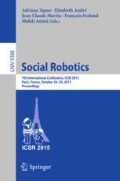Abstract
This paper has the dual aims of introducing and using directional statistics to investigate the comfort levels of pairs of people approached by a robot from different directions. Data from pairs seated in three maximally-different seating configurations are analysed. These data are in the form of circular distributions of ranked comfort levels. Statistical tests for uniformity of circular distributions and for determining if differences exist between pairs of circular distributions are introduced and used to analyse the directional properties of the data. It is shown that directional statistics can be used to compare comfort level ranks that capture all tested robot approach directions; something that cannot be achieved with linear statistics.
Preview
Unable to display preview. Download preview PDF.
References
Mardia, K.V., Jupp, P.E.: Directional Statistics. John Wiley & Sons (2009)
Mardia, K.V.: Statistics of Directional Data. Academic Press (1972)
Dautenhahn, K., Walters, M., Woods, S., Koay, K.L., Nehaniv, C.L., Sisbot, A., Alami, R., Siméon, T.: How may I serve you? a robot companion approaching a seated person in a helping context. In: 1st ACM SIGCHI/SIGART Conf. Human-Robot Interact., pp. 172–179. ACM (2006)
Walters, M.L., Dautenhahn, K., Woods, S.N., Koay, K.L., Te Boekhorst, R., Lee, D.: Exploratory studies on social spaces between humans and a mechanical-looking robot. Connection Science 18(4), 429–439 (2006)
Walters, M.L., Dautenhahn, K., Woods, S.N., Koay, K.L.: Robotic etiquette: results from user studies involving a fetch and carry task. In: 2nd ACM/IEEE Int. Conf. Human-Robot Interact., pp. 317–324. IEEE (2007)
Karreman, D., Utama, L., Joosse, M., Lohse, M., van Dijk, B., Evers, V.: Robot etiquette: how to approach a pair of people? In: ACM/IEEE Int. Conf. Human-Robot Interact., pp. 196–197. ACM (2014)
Ball, A., Silvera-Tawil, D., Rye, D., Velonaki, M.: Group comfortability when a robot approaches. In: Beetz, M., Johnston, B., Williams, M.-A. (eds.) ICSR 2014. LNCS, vol. 8755, pp. 44–53. Springer, Heidelberg (2014)
Hinkelmann, K., Kempthorne, O.: Design and Analysis of Experiments. Introduction to Experimental Design, vol. 1. John Wiley & Sons (1994)
Rao, B.: Nonparametric Functional Estimation. Academic Press (1983)
Siegel, S.: Non-Parametric Statistics. McGraw-Hill (1956)
Jupp, P.: Modifications of the Rayleigh and Bingham tests for uniformity of directions. J. Multivariate Anal. 77(1), 1–20 (2001)
Stuart, A., Ord, J.: Kendall’s Advanced Theory of Statistics, vol. 1. Halsted Press (1994)
Watson, G.S.: Goodness-of-fit tests on a circle II. Biometrika, 57–63 (1962)
Sheskin, D.J.: Handbook of Parametric and Nonparametric Statistical Procedures. CRC Press (2003)
Brown, B.: Grouping corrections for circular goodness-of-fit tests. J. Royal Stat. Soc. Ser. B (Methodological), 275–283 (1994)
Maag, U.R.: A \(k\)-sample analogue of Watson’s \(U^2\) statistic. Biometrika 53(3–4), 579–583 (1966)
Benjamini, Y., Hochberg, Y.: Controlling the false discovery rate: A practical and powerful approach to multiple testing. J. Royal Stat. Soc. Ser. B (Methodological), 289–300 (1995)
Kendon, A.: Spacing and orientation in co-present interaction. In: Esposito, A., Campbell, N., Vogel, C., Hussain, A., Nijholt, A. (eds.) Second COST 2102. LNCS, vol. 5967, pp. 1–15. Springer, Heidelberg (2010)
Ball, A., Rye, D., Silvera-Tawil, D., Velonaki, M.: Group vs. individual comfort when a robot approaches. In: Proc. 24th Int. Symp. Robot and Human Interactive Communication (RO-MAN 2015) (2015) (in press)
Author information
Authors and Affiliations
Corresponding author
Editor information
Editors and Affiliations
Rights and permissions
Copyright information
© 2015 Springer International Publishing Switzerland
About this paper
Cite this paper
Ball, A., Rye, D., Silvera-Tawil, D., Velonaki, M. (2015). Understanding Group Comfort Through Directional Statistics. In: Tapus, A., André, E., Martin, JC., Ferland, F., Ammi, M. (eds) Social Robotics. ICSR 2015. Lecture Notes in Computer Science(), vol 9388. Springer, Cham. https://doi.org/10.1007/978-3-319-25554-5_6
Download citation
DOI: https://doi.org/10.1007/978-3-319-25554-5_6
Published:
Publisher Name: Springer, Cham
Print ISBN: 978-3-319-25553-8
Online ISBN: 978-3-319-25554-5
eBook Packages: Computer ScienceComputer Science (R0)

